The veneration of the Theotokos is of the same order as the veneration of all the saints, and shares with it a common foundation; excepting only that among the saints, the Most Holy Virgin Mary naturally occupies the first place and stands higher than them all.
17-century Fine Russian Icon - Our Lady of Smolensk
Finely executed image of Our Lady of Smolensk. Christ's himation is decorated with intense chrysigraphy. The background is stripped to gesso.
Our Lady of Smolensk is the name of an ancient miracle-working icon and one of the most highly venerated icons in Russia. According to tradition, after the fall of Constantinople, the original icon painted by St. Luke surfaced in Russia, where it was placed in the Assumption Cathedral in Smolensk and therefore referred to as Our Lady of Smolensk. The original icon, dated by art historians to the 11th century, is now believed to have been destroyed by fire during the German occupation of Smolensk in 1941, but a great number of copies were made throughout the century, some of considerable historical and artistic value of their own.
- ID# 421-RSDI-25
- Size 11 3/4 x 10 1/4 inches (30 x 26 cm)
- Age ca. 17th century
- Origin Central Russia
- Materials Egg tempera on wood panel with kovcheg
- Price $7,500
-

1846 Documented reliquary theca with relics of the Tunic of the Blessed Virgin Mary
An opulent Baroque silver reliquary decorated by intricate flowers and an image of the Holy Spirit as a dove containing an oval silver glass-fronted theca housing a Precious Rrelic of the Tunic of the Blessed Virgin Mary. The relic is affixed to the background of red silk surrounded by silver wire ornamentation and titled in Latin on a manuscript cedula label as B.V.M. (the Blessed Virgin Mary). On the back, the theca is secured with a seal of red Spanish wax bearing an imprint of a coat of arms of Monsignor Placido Maria Tadini O.C.D. (†), Archbishop of Genova (1832-1847). The reliquary is accompanied by the original matching authentics document issued by Cardinal Tadini in 1846 where the relic is described in Latin as Ex Tunica B. Mariae Virginis (from the Tunic of the Blessed Virgin Mary).
- ID# 296-RSCR-7
- Size 90 x 60 mm (3 1/2 x 2 1/2 inches)
- Age ca. 1846
- Origin Genoa, Italy
- Materials silver, glass, islk, paper, Spanish wax
- Price SOLD!
-

-

Russian Icon - Coronation of the Virgin Mary, Mother of God
The icon is depicting the Virgin Mary in Heaven being crowned by Christ and God the Father with a dove above them comprisit the New Testament Trinity.
- ID# 262-105-108-SP6-28
- Size 19 x 20 in (48 x 51 cm)
- Age ca. 1880's
- Materials Egg tempera and gilding on gessoed wood
- Price $2,500
-

1768 Large Sicilian reliquary theca with a relics of the Virgin Mary, St. Joseph & 19 saints & Martyrs
Large fancy glass-fronted heart-shaped silver theca with a 1768 hallmark housing relics of 19 saints centered around Ex Velo (of the Veil) relic of the Blessed Virgin Mary and Ex Pallio (of the Coat) relic Her husband St. Joseph.
- ID# 584-RSGSR
- Size 11 x 10 cm (4 1/4 x 3 3/4 inches)
- Age ca. 1768
- Origin Sicily, Italy
- Materials silver, glass, silk, Spanish wax
- Price $5,750
-

Frame Reliquary with relics of St Paschal Baylon, the Virgin Mary & 23 Important Saints
Profusely decorated 19th-century glass-fronted gilt wood frame reliquary housing relics of the Veil of the Blessed Virgin Mary and 23 Important Saints centered around the portrait and relic of St. Paschal Baylon. On the back, the reliquary is secured by a vertical silk cord held in place by two seals of red Spanish wax with an imprint of a coat of arms of Archbishop Fr. Tommaso Michele Salzano (†1890), Titular Bishop of Tanis & Auxiliary Bishop of Napoli (1854-1890)
- ID# 26-RSCRM-5
- Size 34 x 30 cm (13 1/2 in x 11 3/4 in )
- Age ca. 1850s
- Origin Italy, Naples
- Materials Wood, glass, paper, silk, silver, Spanish wax
- Price Price upon request
1861 fine Russian Icon of the Dormition of the Most Holy Mother of God in silver revetment cover
The Dormition of the Most Holy Mother of God is a Great Feast of the Eastern Orthodox Church (corresponding to the Western feast of the Assumption) that commemorates the "falling asleep" or death of the Mother of God, and her bodily resurrection before being taken up into Heaven. The Theotokos is depicted lying on a bier, surrounded by the twelve Apostles. At the center, Jesus Christ is shown in a golden mandorla, swaddling the soul of the Virgin Mary. To either side of him are depicted the Hieromartyrs Dionysius the Areopagite and Ignatius the God-Bearer, who, according to sacred tradition, are responsible for transmitting the account of the dormition. The buildings in the background represent Mary's house and the Temple of Jerusalem. On the lower center, the assault of the High Priest is depicted in which the Jewish priest's hands were cut off by the Archangel Michael after he unsuccessfully tried to overturn Mary's brier.
With St. Phillip the Apostle and St. venerable Anastasiya border saints. The icon is covered by a fine oklad revetment cover of thick silver with hallmarks ИВ and Moscow town marks dated 1861.
- ID# 332-002-107-SP2
- Size 14 1/4 x 11 3/4 inches (36 x 30 cm)
- Age ca. 1861
- Origin Moscow, Russia
- Materials Egg tempera and gilding on gessoed wood in silver revetment cover
- Price $5,500
-

-

Large Russian Icon - The Coronation of The Virgin Mary
The Coronation of the Virgin is a popular subject of the Eastern Orthodox icons, specifically in the Russian Orthodox Church after the 18th century. The New Testament Trinity comprised of Christ, accompanied by God the Father and the Holy Spirit in the form of a dove, is shown while placing a crown on the head of Mary as Queen of Heaven. The coronation of the Virgin Mary as the Queen of Heaven, according to the Church doctrine, is one of the episodes included in the cycle of the Ascension of the Mother of God and the last episode of Her life, which took place immediately after the Ascension. The coronation of the Virgin Mary is celebrated by the Catholic Church on August 22. In Orthodoxy, there is only the feast of the Dormition of the Virgin Mary.
- ID# 17-079-109-SP2
- Size 27 1/2 x 21 1/2 inches (70 x 54 cm)
- Age ca. 1880s
- Origin Provincial Russia
- Materials Egg tempera on gessoed wood
- Price $5,500
-

Large Russian Icon - Our Lady of Tikhvin with 2 border saints
Our Lady of Tikhvin (Tikhvinskaya) is one of the most celebrated and beautiful wonderworking icons of the Mother of God. Traditionally, it is said to be one of the icons painted by Saint Luke the Evangelist and is a contemporary of the Mother of God herself. The appearance of the icon is celebrated on June 26. The icon has a long history. During the Soviet oppression of the Orthodox Church, the original Theotokos of Tikhvin icon was brought to the USA for safekeeping. In 2004 it was transferred back to Russia to return to its home village of Tikhvin. In the iconographic sense, it is a Hodigitria type with the slightly inclined position of the Mother of God toward the Infant, Who is depicted on the left side of the image. The hand of the Mother of God is raised toward her breast as a sign of silent worship of her Son.
The border saints are St. Venerable Cyrill of Radonezh and St. Venerable Pelagia the Penitent (of Antioch).
- ID# 75-039-150-SP2
- Size 20 1/2 x 17 1/2 inches (52 x 44 cm)
- Age ca. 1860s
- Origin Central Russia
- Materials Egg tempera and silvering on gessoed wood
- Price $5,500
-

Russian Icon - Our Lady of Smolensk
Our Lady of Smolensk is the name of an ancient miracle-working icon and one of the most highly venerated icons in Russia. According to tradition, after the fall of Constantinople, the original icon painted by St. Luke surfaced in Russia, where it was placed in the Assumption Cathedral in Smolensk and therefore referred to as Our Lady of Smolensk. The original icon, dated by art historians to the 11th century, is now believed to have been destroyed by fire during the German occupation of Smolensk in 1941, but a great number of copies were made throughout the century, some of the considerable historical and artistic value of their own.
Finely executed on a golden background. Four selected saints on the borders: the Guardian Angel, St. Boniface, St. Venerable Taisia of Egypt, and St. Eudokia of Heliopolis.
- ID# 130-HGI-8
- Size 13 1/2 x 11 3/4 in (34.3 x 29.8 cm)
- Age circa 1800
- Origin Central Russia
- Materials Tempera on wood panel
- Price $4,000
-

Russian Icon - All-Hymned Mother of God with border saints
The Icon “O All-Hymned Mother” derives its title from the thirteenth Kontakion (Hymn) of the Akathist to the Most Holy Theotokos. "O All-Hymned Mother [O Vsepyetaya Mati] bearer of the holiest of holies Word, accept what we offer now, protect us all from every attack, and deliver from the coming torment all those who cry to you." The Mother of God is depicted wearing a crown, and clasping Her child to Her breast with both hands. Christ is held in Her left arm, and rests on Her left shoulder. He is facing Her, and both of His hands are placed below Her neck. Instead of the usual stars on Her head and shoulders, the faces of angels appear in three circles.
The border saints are the Guardian Angel and Saint Anne.
- ID# 157-023-127-SP1
- Size 13 3/4 x 12 1/4 inches (35 x 31 cm)
- Age ca. 1880s
- Origin Central Russia, Old Believers' workshop
- Materials Egg tempera and gilding on gessoed wood
- Price $2,750
-

Russian Icon - Our Lady of Kazan in glass-fronted shadowbox kiot frame
The Teotokos in the iconography of Our Lady of Kazan is depicted on the ground of pure gold imitating the precious revetment cover of the original. The icon is held in a large and ornate glass-fronted shadowbox kiot frame that was painstaikenly restored to near-perfect condition.
- ID# 98-091-106-SP2
- Size Icon: 8 x 9 3/4 inches (20.5 x 24.5 cm), Frame: 18 3/4 x 12 1/4 inches (47.5 x 31 cm)
- Age ca. 1900
- Origin Central Russia
- Materials Egg tempera on gilt, tooled, and gessoed wood held in a glass-fronted shadowbox kiot frame
- Price $2,750
-

Large Russian Icon - The Coronation of The Virgin Mary
The Coronation of the Virgin is a popular subject of the Eastern Orthodox icons, specifically in the Russian Orthodox Church after the 18th century. The New Testament Trinity comprised of Christ, accompanied by God the Father and the Holy Spirit in the form of a dove, is shown while placing a crown on the head of Mary as Queen of Heaven. The coronation of the Virgin Mary as the Queen of Heaven, according to the Church doctrine, is one of the episodes included in the cycle of the Ascension of the Mother of God and the last episode of Her life, which took place immediately after the Ascension. The coronation of the Virgin Mary is celebrated by the Catholic Church on August 22. In Orthodoxy, there is only the feast of the Dormition of the Virgin Mary.
- ID# 52-068-096-SP2
- Size 20 3/4 x 18 inches (53 x 46 cm)
- Age ca. 1890s
- Origin Provincial Russia
- Materials Egg tempera on gessoed wood
- Price $2,750
-

Large Russian Icon - Our Lady of the Sign
Our Lady of the Sign is one of the most beloved Russian miracle-working icons of Theotokos. The icon depicts Her during the Annunciation at the moment of saying, "May it be done to me according to your word." (Luke 1:38). The Virgin Mary is depicted frontally half-length, with her hands raised in a praying position, and the Child Jesus within a round aureole upon her breast representing him at the moment of his conception. The term Virgin of the Sign is a reference to the prophecy of Isaiah 7:14: "Therefore the Lord himself shall give you a sign; Behold, a virgin shall conceive, and bear a son, and shall call his name Immanuel."
- ID# 173-009-133-SP2
- Size 17 1/2 x 14 1/2 inches (44 x 37 cm)
- Age ca. 1880s
- Origin The Old Believer's workshop, Russia
- Materials Egg tempera and gilding on gessoed board
- Price $2,700
-

Russian icon - Joy to All Who Sorrow Mother of God of Moscow
Mother of God, Joy of All Who Sorrow of Moscow is the name of a popular wonderworking Russian Orthodox icon. The icon dates to a miracle that occurred on October 24, 1688, when a woman named Euphemia received healing from sickness after obeying a voice telling her to find this icon and have the priest celebrate a prayer with blessing of water. The design of this icon depicts the Mother of God, depicted full-figured standing with her Son in Heaven and God the Father above her in the clouds. Along both sides of the icon, framing the Mother of God, depicted are many suppliants asking for her intercession. The tenderness and kindness of a loving mother are evident in her face as She stands in paradise and yet among us.
Finely executed with gold highlights. Minor areas of retouching.
- ID# 120-HGI-1
- Size 12 1/4 x 10 1/2 in (31.3 x 26.6 cm)
- Age ca. late 19th century
- Origin Moscow, Russia
- Materials Tempera on wood panel.
- Price $2,500
-

Russian Icon - The Dormition of the Most Holy Mother of God
The Dormition of the Most Holy Mother of God is a Great Feast of the Eastern Orthodox Church (corresponding to the Western feast of the Assumption) which commemorates the "falling asleep" or death of the Mother of God, and her bodily resurrection before being taken up into Heaven. The Theotokos is depicted lying on a bier, surrounded by the twelve Apostles. At the center, Jesus Christ is shown in a golden mandorla, swaddling the soul of the Virgin Mary. On the lower center, the assault of the High Priest is depicted in which the Jewish priest's hands were cut off by the Archangel Michael after he unsuccessfully tried to overturn Mary's brier.
- ID# 610-092-103-SP2
- Size 12 1/4 x 10 1/4 inches (31 x 26 cm)
- Age ca. 1870s
- Origin Vladimir region of Russia
- Materials Egg tempera on gilt and get
- Price $2,500
-

Large Russian Icon - Our Lady of Smolensk
Our Lady of Smolensk is the name of an ancient miracle-working icon and one of Russia's most highly venerated icons. According to tradition, after the fall of Constantinople, the original icon painted by St. Luke surfaced in Russia, where it was placed in the Assumption Cathedral in Smolensk and therefore referred to as Our Lady of Smolensk. The original icon, dated by art historians to the 11th century, is now believed to have been destroyed by fire during the German occupation of Smolensk in 1941, but a great number of copies were made throughout the century, some of considerable historical and artistic value of their own.
- ID# 200-074-100-SP2
- Size 16 1/2 x 13 1/2 inches (42 x 34 cm)
- Age ca. 1900
- Origin Russian icon-painting village of Kholui
- Materials Egg tempera on silvered, tooled, and gessoed wood
- Price $1,750
-

1873 Documented reliquary theca with Sepulcher (Tomb) relic of the Blessed Virgin Mary
Small round glass-fronted brass reliquary theca housing a pebble relic from the Sepulcher of the Blessed Virgin Mary. Precious relic is affixed to a silk ground and identified in Latin on a manuscript cedula label as Ex Sepul. B.V.M. (ex Sepulcher of the Blessed Virgin Mary). On the back, under the protective cap, the theca is secured with a seal of red Spanish wax bearing an imprint of a coat of arms of Fr. Francesco Marinelli, O.E.S.A.(†1887), Titular Bishop of Porphyreon and the Sacristan of the Apostolic Curia (1856-1887). The relic is accompanied by an attractive original matching authentics document issued and sealed by the order of Father Marinelli in 1873.
- ID# 50-281-RSCR-225
- Size 23 mm in diameter
- Age ca. 1873
- Origin Vatican
- Materials brass, glass, silk, paper, Spanish wax
- Price $1,550
-

Russian Icon - Our Lady of Kazan with border saint
Our Lady of Kazan is a holy icon of the highest stature within the Russian Orthodox Church and is considered a palladium of Russia for centuries until its theft and likely destruction in 1904. The icon represents the Virgin Mary as the protector and patroness of the city of Kazan. It is a close-up variant of the Hodegetria (Directress) style, it is noted mainly for the Child standing, with the Virgin chest length. The Kazan icons are traditionally small, following the original. The Kazan icon was very popular in Russia, especially as a wedding gift, and many copies were made in the design of the original. Two major Kazan Cathedrals, in Moscow and St. Petersburg, are consecrated to Our Lady of Kazan, as are numerous churches throughout the land. Her feast days are July 21 and November 4.
- ID# 215-089-102-SP2
- Size 16 1/4 x 14 1/2 inches (41 x 37 cm)
- Age ca. 1870s
- Origin The Old Believer's workshop, Central Russia
- Materials Egg tempera and gilding on gessoed board in contemporary gild frame
- Price $1,500
-

Russian icon - Our Lady of Kazan with two border saints
Our Lady of Kazan is a holy icon of the highest stature within the Russian Orthodox Church and considered a palladium of Russia for centuries, until its theft and likely destruction in 1904. The icon represents the Virgin Mary as the protector and patroness of the city of Kazan. It is a close-up variant of the Hodegetria (Directress) style, it is noted mainly for the Child standing, with the Virgin chest-length. The Kazan icons are traditionally small, following the original. The Kazan icon was very popular in Russia, especially as a wedding gift, and many copies were made in the design of original. Two major Kazan Cathedrals, in Moscow and St. Petersburg, are consecrated to Our Lady of Kazan, as are numerous churches throughout the land. Her feast days are July 21 and November 4.
- ID# 64-1009-011-228-SP1
- Size 12 1/4 x 10 1/2 in (31 x 27 cm)
- Age ca. 1870s
- Origin Central Russia
- Materials Egg tempera and parcel gilding on gessoed wood
- Price $1,275
-

Fine Russian icon - Our Lady of Kazan in silver oklad & kiot shadowbox frame
Fine Russian icon depicting Our Lady of Kazan covered by a finely chased gilt silver oklad revetment cover. The cover of the icon is hallmarked with Moscow town mark dating 1883. The icon is housed in an attractive original glass-fronted wooden kiot shadowbox frame.
- ID# 595-031-144-SP2
- Size in frame: 12 1/2 x 11 inches (32 x 28 cm)
- Age ca. 1883
- Origin Moscow, Russia
- Materials Egg tempera on gessoed wood in parcel gilt silver cover in original glass-fronted wooden kiot shadowframe
- Price $1,275
-

-

Russian icon - Our Lady of the Sign
Our Lady of the Sign is one of the most beloved Russian miracle-working icons of Theotokos. The icon depicts Her during the Annunciation at the moment of saying, "May it be done to me according to your word." (Luke 1:38). The Virgin Mary is depicted frontally half-length, with her hands raised in a praying position, and the Child Jesus within a round aureole upon her breast representing him at the moment of his conception. The term Virgin of the Sign is a reference to the prophecy of Isaiah 7:14: "Therefore the Lord himself shall give you a sign; Behold, a virgin shall conceive, and bear a son, and shall call his name Immanuel."
- ID# 781-016-173-SP2
- Size 12 1/4 x 10 1/4 inches (31 x 26 cm)
- Age ca. 1850's
- Origin Old Believer's workshop
- Materials Egg tempera on parcel gilt and gessoed wood
- Price $1,275
-

Russian Icon - Our Lady of Iveron with 2 border Saints
Our Lady of Iveron is the Eastern Orthodox icon of the Virgin Mary which, according to the Sacred Tradition, was painted by Luke the Evangelist. The icon is referred to as "Wonderworking" meaning that numerous miracles have been attributed to the intercession of the Theotokos by persons praying before it. The original of this image is found in the Georgian Iveron monastery on Mount Athos in Greece, where it is believed to have been since the year 999.
- ID# 120-1009-017-156-SP1
- Size 13 3/4 x 11 3/4 inches (35 x 30 cm)
- Age ca. 19th century
- Origin Central Russia
- Materials Egg tempera and gilding on gessoed wood
- Price $1,250
-

Russian Icon - Our Lady of Kazan
Our Lady of Kazan is a holy icon of the highest stature within the Russian Orthodox Church and is considered a palladium of Russia for centuries until its theft and likely destruction in 1904. The icon represents the Virgin Mary as the protector and patroness of the city of Kazan. It is a close-up variant of the Hodegetria (Directress) style, it is noted mainly for the Child standing, with the Virgin chest length. The Kazan icons are traditionally small, following the original. The Kazan icon was very popular in Russia, especially as a wedding gift, and many copies were made in the design of the original. Two major Kazan Cathedrals, in Moscow and St. Petersburg, are consecrated to Our Lady of Kazan, as are numerous churches throughout the land. Her feast days are July 21 and November 4.
- ID# 418-046-063-SP2
- Size 13 3/4 x 11 3/4 inches (35 x 30 cm)
- Age ca. 1880s
- Origin Central Russia
- Materials Egg tempera on silvered, tooled, and gessoed wood
- Price $1,250
-

Russian Icon - Our Lady of Joy to All Who Sorrow in brass revetment cover
Mother of God, Joy to All Who Sorrow of Moscow is the name of a famous wonderworking Russian Orthodox icon. The icon dates to a miracle that occurred on October 24, 1688, when a woman named Euphemia received healing from sickness after obeying a voice telling her to find this icon and have the priest celebrate a prayer with the blessing of water. The design of this icon depicts the Mother of God, depicted full-figured standing with her Son in Heaven and God the Father above her in the clouds. Along both sides of the icon, framing the Mother of God, depicted are many suppliants asking for her intercession. The tenderness and kindness of a loving mother are evident in her face as She stands in paradise and yet among us.
- ID# 252-012-344-SP2
- Size 15 3/4 x 13 3/4 inches (40 x 35 cm)
- Age ca. 1900
- Origin Russian icon-painting village of Kholui
- Materials Egg tempera in gessoed wood in brass revetment cover with 2 porcelain medallions
- Price $1,225
-

Large Russian Icon - the Coronation of the Virgin Mary in brass revetment cover
The Coronation of the Virgin is is a popular subject among Eastern Orthodox icons, specifically in the Russian Orthodox Church after the 18th century. The New Testament Trinity comprised of Christ, accompanied by God the Father and the Holy Spirit in the form of a dove, is shown while placing a crown on the head of Mary as Queen of Heaven. The coronation of the Virgin Mary as the Queen of Heaven, according to the Church doctrine, is one of the episodes included in the cycle of the Ascension of the Mother of God and the last episode of Her life, which took place immediately after the Ascension. The coronation of the Virgin Mary is celebrated by the Catholic Church on August 22. In Orthodoxy, there is only the feast of the Dormition of the Virgin Mary.
- ID# 217-073-093-SP2
- Size 16 1/4 x 13 inches (41 x 33 cm)
- Age ca. 1880s
- Origin Provincial Russia
- Materials Egg tempera on gessoed wood in silvered brass revetment cover
- Price $1,225
-

Russian Icon - Feodorovskaya Mother of God
The Feodorovskaya Icon of the Mother of God, also known as Our Lady of Saint Theodore and the Black Virgin Mary of Russia is the patron icon of the Romanov Imperial family and one of the most venerated icons in the Upper Volga region. Her feast days are March 27 and August 29.
- ID# 77-1009-012-204-SP1
- Size 12 1/4 x 10 1/4 in (31 x 26 cm)
- Age ca. 1800
- Origin Volga Region of Russia
- Materials Egg tempera and gilding on gessoed wood
- Price $1,200
-

Russian Icon - Our Lady of Kazan in silver revetment cover & glass-fronted shadowbox kiot frame
Our Lady of Kazan is a holy icon of the highest stature within the Russian Orthodox Church and is considered a palladium of Russia for centuries until its theft and likely destruction in 1904. The icon represents the Virgin Mary as the protector and patroness of the city of Kazan. It is a close-up variant of the Hodegetria (Directress) style, it is noted mainly for the Child standing, with the Virgin chest length. The Kazan icons are traditionally small, following the original. The Kazan icon was very popular in Russia, especially as a wedding gift, and many copies were made in the design of the original. Two major Kazan Cathedrals, in Moscow and St. Petersburg, are consecrated to Our Lady of Kazan, as are numerous churches throughout the land. Her feast days are July 21 and November 4.
The icon's cover is stamped with a Moscow hallmark dated 1890 and a silver purity mark of 84 zolotniks.
- ID# 1099-017-171-SP2
- Size 10 1/2 x 9 1/2 inches (27 x 24 cm)
- Age ca. 1890
- Origin Moscow, Russia
- Materials oil on gessoed wood in gilt silver revetment cover held in wooden shadowbox frame
- Price $1,200
-

-

Russian icon - Our Lady of Kazan in silver oklad & kiot shadowbox frame
Our Lady of Kazan is a holy icon of the highest stature within the Russian Orthodox Church and is considered a palladium of Russia for centuries until its theft and likely destruction in 1904. The icon represents the Virgin Mary as the protector and patroness of the city of Kazan. It is a close-up variant of the Hodegetria (Directress) style, it is noted mainly for the Child standing, with the Virgin chest length. The Kazan icons are traditionally small, following the original. The Kazan icon was very popular in Russia, especially as a wedding gift, and many copies were made in the design of the original. Two major Kazan Cathedrals, in Moscow and St. Petersburg, are consecrated to Our Lady of Kazan, as are numerous churches throughout the land. Her feast days are July 21 and November 4.
- ID# 1069-008-086-SP2
- Size 11 x 9 1/2 inches (28 x 24 cm)
- Age ca. 1910
- Origin Moscow, Russia
- Materials Egg tempera on gessoed wood in parcel gilt silver cover, glass-fronted shadowbox kit frame
- Price $1,200
-

-

Russian Icon - Our Lady of Vladimir
Our Lady of Vladimir is one of the most highly venerated Orthodox icons and a typical example of Byzantine iconography. The original 12th-century icon survived and is displayed in the Tretyakov Gallery museum in Moscow. Even more than most famous icons, the original has been copied repeatedly for centuries and many copies now have considerable artistic and religious significance of their own. The icon is a version of the Eleusa (Tenderness) type, with the Christ child snuggling up to his mother's cheek. The venerated image was used to celebrate the coronations of tsars, the elections of patriarchs, and other important ceremonies of the Russian state. Her feast day is June 3.
- ID# 684-054-061-SP2
- Size 12 1/4 x 10 1/2 inches (31 x 27 cm)
- Age ca. 1890s
- Origin Central Russia
- Materials Egg tempera on silvered, tooled, and gessoed wood
- Price $1,200
-

Russian Icon - Joy to All Who Sorrow Mother of God with border Saints - St. Irene & St. Cyril
Mother of God, Joy to All Who Sorrow of Moscow is the name of a famous wonderworking Russian Orthodox icon. The icon dates to a miracle that occurred on October 24, 1688, when a woman named Euphemia received healing from sickness after obeying a voice telling her to find this icon and have the priest celebrate a prayer with the blessing of water. The design of this icon depicts the Mother of God, depicted full-figured standing with her Son in Heaven and blessing Christ above her in the clouds. Along both sides of the icon, framing the Mother of God, depicted are many suppliants asking for her intercession assisted by the angels. The tenderness and kindness of a loving mother are evident in her face as She stands in paradise and yet among us.
The border saints are St. Irene and St. Cyril
- ID# 356-004-176-SP2
- Size 14 1/4 x 12 1/4 inches (36 x 31 cm)
- Age ca. 1880s
- Origin Central Russia
- Materials Egg tempera on parcel gilt and gessoed wood
- Price $1,200
-

Russian Icon - Our Lady of Smolensk
Our Lady of Smolensk is the name of an ancient miracle-working icon and one of the most highly venerated icons in Russia. According to tradition, after the fall of Constantinople, the original icon painted by St. Luke surfaced in Russia, where it was placed in the Assumption Cathedral in Smolensk and therefore referred to as Our Lady of Smolensk. The original icon, dated by art historians to the 11th century, is now believed to have been destroyed by fire during the German occupation of Smolensk in 1941, but a great number of copies were made throughout the century, some of considerable historical and artistic value of their own.
- ID# 281-083-050-SP2
- Size 15 x 11 3/4 inches (38 x 30 cm)
- Age ca. 1880s
- Origin Provincial Russia
- Materials Egg tempera on gessoed wood
- Price $1,200
-

Russian Icon - The Deisis, 8 Miracleworking Madonnas & Selected Saints
The icon depicts the following eight miracle-working Madonnas surrounding the Orthodox Deisis: Our Lady of Kazan, Our Lady of the Unexpected Joy, Sooth My Sorrow Mother of God, Soothing of the Evil Hearts Mother of God, Theodorovsky Mother of God, Our Lady of Częstochowa, Our Lady of Tikhvin, Our Lady of Akhtyrsk. A row of full-figured local saints is depicted below them.
- ID# 400-046-018-SP2
- Size 13 3/4 x 12 1/2 inches (35 x 31 cm)
- Age ca. 1880s
- Origin Western Russia, Old Believer's workshop
- Materials Egg tempera and gilding on gessoed wood
- Price $1,200
-

Russian Icon - Our Lady of the Sign
Our Lady of the Sign is one of the most beloved Russian miracle-working icons of Theotokos. The icon depicts Her during the Annunciation at the moment of saying, "May it be done to me according to your word." (Luke 1:38). The Virgin Mary is depicted frontally half-length, with her hands raised in a praying position, and the Child Jesus within a round aureole upon her breast representing him at the moment of his conception. The term Virgin of the Sign is a reference to the prophecy of Isaiah 7:14: "Therefore the Lord himself shall give you a sign; Behold, a virgin shall conceive, and bear a son, and shall call his name Immanuel."
- ID# 318-004-132-SP2
- Size 14 1/2 x 11 1/2 inches (37 x 29 cm)
- Age ca. 1900
- Origin Central Russia
- Materials Egg tempera on gilt, tooled, and gessoed wood
- Price $1,100
-

Russian Icon - Our Lady of Smolensk
Our Lady of Smolensk is the name of an ancient miracle-working icon and one of the most highly venerated icons in Russia. According to tradition, after the fall of Constantinople, the original icon painted by St. Luke surfaced in Russia, where it was placed in the Assumption Cathedral in Smolensk and therefore referred to as Our Lady of Smolensk. The original icon, dated by art historians to the 11th century, is now believed to have been destroyed by fire during the German occupation of Smolensk in 1941, but a great number of copies were made throughout the century, some of considerable historical and artistic value of their own.
- ID# 790-012-172-SP2
- Size 12 1/4 x 10 1/4 inches (31 x 26 cm)
- Age ca. second half of the 19th century
- Origin Central Russia
- Materials Egg tempera on gilt and gessoed wood
- Price $1,100
-

Russian icon - Our Lady of Kazan in silver oklad & kiot shadowbox frame
Our Lady of Kazan is a holy icon of the highest stature within the Russian Orthodox Church and is considered a palladium of Russia for centuries until its theft and likely destruction in 1904. The icon represents the Virgin Mary as the protector and patroness of the city of Kazan. It is a close-up variant of the Hodegetria (Directress) style, it is noted mainly for the Child standing, with the Virgin chest length. The Kazan icons are traditionally small, following the original. The Kazan icon was very popular in Russia, especially as a wedding gift, and many copies were made in the design of the original. Two major Kazan Cathedrals, in Moscow and St. Petersburg, are consecrated to Our Lady of Kazan, as are numerous churches throughout the land. Her feast days are July 21 and November 4.
- ID# 1226-002-001-SP2
- Size 10 1/4 x 9 inches (26 x 23 cm)
- Age ca. 1880s
- Origin Moscow, Russia
- Materials Egg tempera on gessoed wood in parcel gilt silver cover, beads, glass-fronted shadowbox kit frame
- Price $1,000
-

-

Large Russian icon - Our Lady of the Sign
Our Lady of the Sign is one of the most beloved Russian miracle-working icons of Theotokos. The icon depicts Her during the Annunciation at the moment of saying, "May it be done to me according to your word." (Luke 1:38). The Virgin Mary is depicted frontally half-length, with her hands raised in a praying position, and the Child Jesus within a round aureole upon her breast representing him at the moment of his conception. The term Virgin of the Sign refers to the prophecy of Isaiah 7:14: "Therefore the Lord himself shall give you a sign; Behold, a virgin shall conceive, and bear a son, and shall call his name Immanuel."
- ID# 146-091-028-SP2
- Size 17 1/3 x 14 1/2 inches (44 x 37 cm)
- Age ca. 1890
- Origin Provincial Russia
- Materials Egg tempera on gessoed wood
- Price $1,000
-

Russian Icon - Our Lady of the Sign
Our Lady of the Sign is one of the most beloved Russian miracle-working icons of Theotokos. The icon depicts Her during the Annunciation at the moment of saying, "May it be done to me according to your word." (Luke 1:38). The Virgin Mary is depicted frontally half-length, with her hands raised in a praying position, and the Child Jesus within a round aureole upon her breast representing him at the moment of his conception. The term Virgin of the Sign is a reference to the prophecy of Isaiah 7:14: "Therefore the Lord himself shall give you a sign; Behold, a virgin shall conceive, and bear a son, and shall call his name Immanuel."
- ID# 231-092-109-SP2
- Size 15 3/4 x 13 inches (40 x 33 cm)
- Age ca. 1900
- Origin Russian icon-painting village of Kholui
- Materials Egg tempera on tooled, silvered, and gessoed wood
- Price $1,000
-

Reliquary theca with a relics of the Blessed Virgin Mary, St. Joseph & 9 Catholic Saints
Oval glass-fronted brass pendant reliquary theca housing precious relics of the Blessed Virgin Mary, Saint Joseph, and nine Catholic Saints: Saint Clare of Assisi, Saint Veronica Giuliani, Saint Anthony of Padua, Saint Aloysius Gonzaga, Saint Sabinus Bishop of Canossa, Saint Victor of Milan, Saint Francis of Assisi, Saint Pacificus of San Severino, and a pre-canonization relic of Saint Leonard of Port Maurice. The relics are affixed to a blue silk ground, surrounded by silver wire ornamentation, and identified in Latin on typeset cedulae labels. On the back, the theca is secured with a perfectly preserved seal of red Spanish wax bearing an imprint of a coat of arms of Cardinal Guido Maria Conforti (†), Archbishop of Parma (1907-1931), who was himself canonized as a Saint in 2011.
- ID# 69-RSCR98-9
- Size 49 x 38 mm
- Age ca. 1850s
- Origin Italy
- Materials brass, glass, silk, paper, silver, Spanish wax
- Price $975
Russian Icon - Our Lady of Smolensk
Our Lady of Smolensk is name of an ancient miracle working icon and one of the most highly venerated icons in Russia. According to the tradition, after the fall of Constantinople, the original icon painted by St. Luke surfaced in Russia, where it was placed in the Assumption Cathedral in Smolensk and therefore referred to as Our Lady of Smolensk. The original icon, dated by art historians to the 11th century, is now believed to have been destroyed by fire during the German occupation of Smolensk in 1941, but a great number of copies were made throughout the century, some of the of considerable historical and artistic value of their own.
- ID# 146-105-093-SP7-1
- Size 12 1/4 x 9 3/4 in (31 x 25 cm)
- Age ca. 18/19th century
- Materials Egg tempera and gilding on gessoed wood
- Price $975
-

Russian Icon - Mother of God, Joy to All Who Sorrow
Mother of God, Joy to All Who Sorrow of Moscow is the name of a famous wonderworking Russian Orthodox icon. The icon dates to a miracle that occurred on October 24, 1688, when a woman named Euphemia received healing from sickness after obeying a voice telling her to find this icon and have the priest celebrate a prayer with the blessing of water. The design of this icon depicts the Mother of God, depicted full-figured standing with her Son in Heaven and God the Father above her in the clouds. Along both sides of the icon, framing the Mother of God, depicted are many suppliants asking for her intercession. The tenderness and kindness of a loving mother are evident in her face as She stands in paradise and yet among us.
- ID# 345-083-096-SP1
- Size 12 1/4 x 10 1/2 inches (31 x 27 cm)
- Age ca. 1880s
- Origin Central Russia (the Urals?)
- Materials Egg tempera on gilt and gessoed wood
- Price $975
-

Russian Icon - Quick To Hear Mother of God
The Icon of the Mother of God, Quick to Hear, is an ancient wonderworking icon, located on Holy Mt. Athos. The monastery's tradition suggests that the icon was written during the tenth century. ”Let them and all Orthodox Christians come to Me in their necessities, and I shall not forsake them. All their petitions will be granted by My Son, because of My intercession with Him. My icon shall be called ‘She who is Quick to Hear,’ for I shall speedily fulfill the petitions of those who hasten to it.” In Russia, copies of the wonderworking Athonite image “She who is Quick to Hear” were always venerated with great love and fervent prayer. Many of them were glorified by miracles. In particular, there were cases of healing from the plague and from demonic possession.
- ID# 609-001-134-SP2
- Size 12 1/2 x 10 1/2 inches (32 x 27 cm)
- Age ca. 1900
- Origin Provincial Russia
- Materials Egg tempera on gilt and gessoed wood
- Price $975
-

Russian Icon - Our Lady of Kazan
Our Lady of Kazan is a holy icon of the highest stature within the Russian Orthodox Church and is considered a palladium of Russia for centuries until its theft and likely destruction in 1904. The icon represents the Virgin Mary as the protector and patroness of the city of Kazan. It is a close-up variant of the Hodegetria (Directress) style, it is noted mainly for the Child standing, with the Virgin chest length. The Kazan icons are traditionally small, following the original. The Kazan icon was very popular in Russia, especially as a wedding gift, and many copies were made in the design of the original. Two major Kazan Cathedrals, in Moscow and St. Petersburg, are consecrated to Our Lady of Kazan, as are numerous churches throughout the land. Her feast days are July 21 and November 4.
- ID# 639-091-086-SP2
- Size 12 1/4 x 10 1/4 inches (31 x 26 cm)
- Age ca. 1880s
- Origin Central Russia
- Materials Egg tempera on parcel silvered and gessoed wood
- Price $975
-

Russian Icon - Our Lady of Kazan
Our Lady of Kazan, is a holy icon of the highest stature within the Russian Orthodox Church and considered a palladium of Russia for centuries, until its theft and likely destruction in 1904. The icon represents the Virgin Mary as the protector and patroness of the city of Kazan. It is a close-up variant of the Hodegetria (Directress) style, it is noted mainly for the Child standing, with the Virgin chest-length. The Kazan icons are traditionally small, following the original. The Kazan icon was very popular in Russia, especially as a wedding gift, and many copies were made in the design of the original. Two major Kazan Cathedrals, in Moscow and St. Petersburg, are consecrated to Our Lady of Kazan, as are numerous churches throughout the land. Her feast days are July 21 and November 4.
- ID# 183-028-132-SP6-11
- Size 13 3/4 x 11 3/4 in (35 x 30 cm)
- Age ca. 1880's
- Origin Icon painting village of Kholui
- Materials Egg tempera and gilding on gessoed wood
- Price $950
-

Russian Icon - Our Lady of Vladimir
Our Lady of Vladimir is one of the most highly venerated Orthodox icons and a typical example of Byzantine iconography. The original 12th-century icon survived and is displayed in the Tretyakov Gallery museum in Moscow. Even more than most famous icons, the original has been copied repeatedly for centuries and many copies now have considerable artistic and religious significance of their own. The icon is a version of the Eleusa (Tenderness) type, with the Christ child snuggling up to his mother's cheek. The venerated image was used in the celebration of coronations of Tsars, elections of Patriarchs, and other important ceremonies of the Russian state. Her feast day is June 3.
- ID# 110-1009-014-265-SP1
- Size 12 1/2 x 10 1/2 inches (32 x 27 cm)
- Age ca. 19th century
- Origin Provincial Russia
- Materials Egg tempera and gilding on gessoed wood
- Price $950
-

Russian Icon - the Surety of Sinners Mother of God
The Icon of the Surety of Sinners Mother of God is known by this name because of the inscription on the icon: “I am the Surety of sinners for My Son Who has entrusted Me to hear them, and those who bring Me the joy of hearing them will receive eternal joy through Me.” The Mother of God is depicted embracing Her Child, Who holds Her right hand with both His hands so that Her thumb is in His right hand, and Her small finger in His left hand. This is the gesture of one who gives surety for another. Although we do not know when or by whom the icon was originally painted, it is believed that the basis of the icon is to be found in the Akathist to the Protection of the Most Holy Theotokos: “Rejoice, You Who offer Your hands in surety for us to God.”
- ID# 128-1009-017-255-SP1
- Size 11 3/4 x 10 1/4 inches (30 x 26 cm)
- Age ca. 19th century
- Origin Provincial Russia
- Materials Egg tempera on gessoed wood
- Price $950
-

Russian Icon - The Annunciation of the Virgin Mary
The Annunciation of the Blessed Virgin Mary, is the Christian celebration of the announcement by the angel Gabriel to the Virgin Mary that she would conceive and become the mother of Jesus, the Son of God, marking his Incarnation. Gabriel is shown blessing with one hand and holding a stem of lilies in the other, while the Virgin Mary is depicted turned towards the Angel holding the book of Gospels opened on Luke (1:29): "You will conceive and give birth to a son, and you are to call him Jesus."
- ID# 1040-013-182-SP2
- Size 11 1/2 x 8 1/2 inches
- Age ca. 1880s
- Origin Provincial Russia
- Materials Egg tempera and gilding on gessoed wood
- Price $950
-

Russian Icon - Our Lady of Tikhvin
Our Lady of Tikhvin (Tikhvinskaya) is one of the most celebrated and beautiful wonderworking icons of the Mother of God. Traditionally, it is said to be one of the icons painted by Saint Luke the Evangelist and is a contemporary of the Mother of God herself. The appearance of the icon is celebrated on June 26. The icon has a long history. During the Soviet oppression of the Orthodox Church, the original Theotokos of Tikhvin icon was brought to the USA for safekeeping. In 2004 it was transferred back to Russia to return to its home village of Tikhvin. In the iconographic sense, it is a Hodigitria type with the slightly inclined position of the Mother of God toward the Infant, Who is depicted on the left side of the image. The hand of the Mother of God is raised toward her breast as a sign of silent worship of her Son.
- ID# 306-066-025-SP2
- Size 14 1/2 x 11 3/4 inches (37 x 30 cm)
- Age ca. 1890
- Origin Icon-painting village of Kholui, Vladimir region of Russia
- Materials Egg tempera on silvered, tooled, and gessoed wood
- Price $925
-

Russian icon - Our Lady of Tikhvin
Our Lady of Tikhvin (Tikhvinskaya) is one of the most celebrated and beautiful wonderworking icons of the Mother of God. Traditionally, it is said to be one of the icons painted by Saint Luke the Evangelist and is a contemporary of the Mother of God herself. The appearance of the icon is celebrated on June 26. The icon has a long history. During the Soviet oppression of the Orthodox Church, the original Theotokos of Tikhvin icon was brought to the USA for safekeeping. In 2004 it was transferred back to Russia to return to its home village of Tikhvin. In the iconographic sense, it is a Hodigitria type with the slightly inclined position of the Mother of God toward the Infant, Who is depicted on the left side of the image. The hand of the Mother of God is raised toward her breast as a sign of silent worship of her Son.
- ID# 100-1009-014-060-SP1
- Size 12 1⁄4 x 10 1⁄2 inches (26.5 x 22 cm)
- Age ca. 1890s
- Origin Provincial Russia
- Materials Egg tempera on gessoed wood
- Price $895
-

Russian Icon - Our Lady of Akhtyrsk
Locally venerated Our Lady of Akhtyrsk is named after the town where it miraculously appeared in 1739 when the priest Daniil Vasiliev found it in the grass while mowing with a scythe. It depicts the Mother of God half-figured in an attitude of prayer with a smaller figure of crucified Christ shown to her right. Her feast day is July 2.
- ID# 1074-013-146-SP2
- Size 11 x 9 inches (28 x 23 cm)
- Age ca. 1870s
- Origin Southern Russia
- Materials Egg tempera on gessoed wood
- Price $875
-

Small Russian Icon - the Pokrov, the Protection of the Most Holy Mother of God in silver cover
The finely executed silver cover is hallmarked with the date 1817 and the workmaster's initials A•Я and T•R.
- ID# 1309-026-288-SP2
- Size 6 3/4 x 5 inches (17 x 13 cm)
- Age ca. 1817
- Origin Central Russia
- Materials egg tempera on gessoed wood in silver cover
- Price $875
-

-

Russian Icon - Our Lady of Kazan in brass revetment cover
Our Lady of Kazan is a holy icon of the highest stature within the Russian Orthodox Church and is considered a palladium of Russia for centuries until its theft and likely destruction in 1904. The icon represents the Virgin Mary as the protector and patroness of the city of Kazan. It is a close-up variant of the Hodegetria (Directress) style, it is noted mainly for the Child standing, with the Virgin chest length. The Kazan icons are traditionally small, following the original. The Kazan icon was very popular in Russia, especially as a wedding gift, and many copies were made in the design of the original. Two major Kazan Cathedrals, in Moscow and St. Petersburg, are consecrated to Our Lady of Kazan, as are numerous churches throughout the land. Her feast days are July 21 and November 4.
- ID# 702-037-087-SP2
- Size 12 1/4 x 10 1/2 inches (31 x 27 cm)
- Age ca. 1900
- Origin Provincial Russia
- Materials Egg tempera on gessoed wood in silvered brass revetment cover with enameled roundels in corners
- Price $875
-

Russian Icon - Joy to All Who Sorrow Mother of God with coins
Mother of God, Joy of All Who Sorrow of Saint Petersburg is a miracle working icon celebrated throughout Russia. On July 23, 1888, during the severe thunderstorm, lightning struck a chapel at a glass factory in St. Petersburg, burning the interior walls of the church, but leaving the icon depicting Mother of God, Joy of All Who Sorrow unharmed. From the violent disturbance of the air, the icon was knocked to the floor, the poor-box broke open, and twelve copper coins adhered to the icon in various places; afterwards many miracles were worked by the grace of the holy icon. The design of this icon depicts the Mother of God, standing in paradise with her Son above her. Along both sides of the icon, framing the Mother of God, are suppliants, asking for her intercession with angels assisting them. The 12 coins are depicted throughout the central field of the icon.
- ID# 685-055-073-SP2
- Size 12 1/2 x 9 3/4 inches (31.5 x 25 cm)
- Age ca. 1900
- Origin Central Russia
- Materials Egg tempera on gilt, tooled, and gessoed wood
- Price $875
-

Russian Icon - Four Miracleworking Madonnas
Russian icon of four parts depicting Miracleworking Madonnas: Our Lady of Chernihiv, the Quick-to-Hear Madonna, Mother Of God Of Chenstokhovskaya (The Softener Of The Evil Hearts), and Our Lady Seeker of the Perished.
- ID# 789-012-170-SP2
- Size 12 1/4 x 10 1/4 inches (31 x 26 cm)
- Age ca. 1880s
- Origin Central Russia
- Materials Egg tempera on silvered and gessoed wood
- Price $875
-

Russian Icon - Presentation of the Virgin Mary at the Temple
The icon is depicting The Presentation of the Blessed Virgin Mary, known in the East as The Entry of the Most Holy Theotokos into the Temple – a liturgical feast celebrated on November 21 by the Catholic, Orthodox Churches, and some Anglo-Catholic Churches. The feast is associated with an event recounted in the apocryphal Protoevangelium of James. According to that text, Mary's parents, Joachim and Anne, who had been childless, received a heavenly message that they would have a child. In thanksgiving for the gift of their daughter, they brought her, when still a child, to the Temple in Jerusalem to consecrate her to God. Tradition held that she was to remain there to be educated in preparation for her role as Mother of God. In Eastern Orthodox tradition, this is one of the days when women named Mary are celebrating their name day.
- ID# 225-098-016-SP7-11
- Size 14 1/4 x 9 3/4 in (36 x 25 cm)
- Age ca. 1890
- Origin Provincial Russia
- Materials Oil on gessoed wood
- Price $850
-

Russian icon - Our Lady of Iveron in kiot shadow frame
Our Lady of Iveron is the Eastern Orthodox icon of the Virgin Mary which, according to the Sacred Tradition, was painted by Luke the Evangelist. The icon is referred to as "Wonderworking" meaning that numerous miracles have been attributed to the intercession of the Theotokos by persons praying before it. The original of this image is found in the Georgian Iveron monastery on Mount Athos in Greece, where it is believed to have been since the year 999.
- ID# 374-104-079-SP1
- Size 11 1/2 x 9 3/4 inches (29 x 25 cm)
- Age ca. 1890s
- Origin Provincial Russia
- Materials Egg tempera on silvered, tooled and gessoed wood in glass fronted shadow frame
- Price $850
-

Russian Icon - Mother of God Joy to All Who Sorrow with Coins
Mother of God, Joy of All Who Sorrow of Saint Petersburg is a miracle working icon celebrated throughout Russia. On July 23, 1888, during the severe thunderstorm, lightning struck a chapel at a glass factory in St. Petersburg, burning the interior walls of the church, but leaving the icon depicting Mother of God, Joy of All Who Sorrow unharmed. From the violent disturbance of the air, the icon was knocked to the floor, the poor-box broke open, and twelve copper coins adhered to the icon in various places; afterwards many miracles were worked by the grace of the holy icon. The design of this icon depicts the Mother of God, standing in paradise with her Son above her. Along both sides of the icon, framing the Mother of God, are suppliants, asking for her intercession with angels assisting them. The 12 coins are depicted throughout the central field of the icon.
- ID# 1071-015-019-SP2
- Size 11 x 9 1/2 inches (28 x 24 cm)
- Age ca. 1900
- Origin Saint Petersburg Russia
- Materials Egg tempera on gilt, tooled & gessoed wood in contemporary gilt frame
- Price $850
-

Small Russian Icon - the Vision of St. Sergius of Radonezh in silver cover
The finely executed silver cover is hallmarked with 84 zolotniks silver purity mark and the worksmaster's initials.
- ID# 1367-020-114-SP2
- Size 7 x 5 1/4 inches (17 x 13.5 cm)
- Age ca. 1870s
- Origin Central Russia
- Materials Egg tempera on gessoed wood in silver revetment cover
- Price $825
-

-

Russian Icon - Soothe My Sorrow Mother of God with 2 border saints
Soothe My Sorrows Mother of God is the name of a wonderworking icon treasured in the Church of St. Nikolaev Odrin Monastery in Karachev, Orlov province and copies of this icon are to be found in churches all over Moscow. The Mother of God is depicted crowned with a hand bending toward her head and with the Child holding a scroll in both hands directly sitting on her left hand. On the scroll are the words: "Judge righteously; each show mercy to one another; do not offend widows and orphans, and do not keep malice in your heart towards your brother." Tradition relates that the first time this icon was glorified was in the second half of the 18th century when the miraculous power was revealed through a certain woman who had been suffering from a weakness in her hands and feet. Physicians were not able to help her with her ailment and in a vision, she was told to go to Moscow and pray before the icon of the Mother of God bearing the inscription "Soothe my Sorrows;" in the same vision, she was shown the icon. Not finding that icon in the church, she turned to the priest for help, who then brought all of the ancient icons down from the bell tower. One of the icons bore the inscription "Soothe my Sorrows." As soon as the woman saw the icon, she exclaimed: “It is she! It is she!” After a prayer, the ailing woman felt so much stronger that she was able to stand and leave the church unaided.
- ID# 377-106-108-SP1
- Size 12 1/4 x 10 1/4 inches (31 x 26 cm)
- Age ca. 1900
- Origin Provincial Russia
- Materials Egg tempera on silvered, tooled, and gessoed wood
- Price (RESERVED)
-

Reliquary theca with relics of Sepulchre of the Blessed Virgin Mary
Oval silver glass-fronted theca housing a particle relic from the Sepulchre of the Blessed Virgin Mary. The relic is affixed to a red background and identified on a typeset cedula label as Sep[ulchre] B.V.M. On the back, the theca is secured by a seal of red Spanish wax with an imprint of a coat of arms of Cardinal Pietro Respighi (†1913), Vicar General of Rome (1900-1913).
- ID# 34-RSCR40-11
- Size 39 x 31 mm
- Age ca. 1900
- Origin Italy
- Materials glass, silver
- Price $775
-

Russian Icon - Our Lady of Smolensk
Our Lady of Smolensk is the name of an ancient miracle working icon and one of the most highly venerated icons in Russia. According to tradition, after the fall of Constantinople, the original icon painted by St. Luke surfaced in Russia, where it was placed in the Assumption Cathedral in Smolensk and therefore referred to as Our Lady of Smolensk. The original icon, dated by art historians to the 11th century, is now believed to have been destroyed by fire during the German occupation of Smolensk in 1941, but a great number of copies were made throughout the century, some of considerable historical and artistic value of their own.
- ID# 673-083-078-SP2
- Size 12 1/4 x 10 1/4 inches (31 x 26 cm)
- Age ca. 1890s
- Origin Upper Volga region of Russia
- Materials Egg tempera on silvered, tooled, and gessoed wood
- Price $775
-

Russian Icon - Our Lady of Tikhvin
Our Lady of Tikhvin (Tikhvinskaya) is one of the most celebrated and beautiful wonderworking icons of the Mother of God. Traditionally, it is said to be one of the icons painted by Saint Luke the Evangelist and is a contemporary of the Mother of God herself. The appearance of the icon is celebrated on June 26. The icon has a long history. During the Soviet oppression of the Orthodox Church, the original Theotokos of Tikhvin icon was brought to the USA for safekeeping. In 2004 it was transferred back to Russia to return to its home village of Tikhvin. In the iconographic sense, it is a Hodigitria type with the slightly inclined position of the Mother of God toward the Infant, Who is depicted on the left side of the image. The hand of the Mother of God is raised toward her breast as a sign of silent worship of her Son.
- ID# 886-040-125-SP2
- Size 12 1/4 x 10 1/4 inches (31 x 25 cm)
- Age ca. late 19th century
- Origin Central Russia
- Materials Egg tempera on gessoed wood
- Price $775
-

Russian Icon - Sooth my Sorrow Mother of God in brass revetment cover
Soothe My Sorrows Mother of God is the name of a wonderworking icon treasured in the Church of St. Nikolaev Odrin Monastery in Karachev, Orlov province and copies of this icon are to be found in churches all over Moscow. The Mother of God is depicted crowned with a hand bending toward her head and with the Child holding a scroll in both hands directly sitting on her left hand. On the scroll are the words: "Judge righteously; each show mercy to one another; do not offend widows and orphans, and do not keep malice in your heart towards your brother." Tradition relates that the first time this icon was glorified was in the second half of the 18th century when the miraculous power was revealed through a certain woman who had been suffering from a weakness in her hands and feet. Physicians were not able to help her with her ailment and in a vision, she was told to go to Moscow and pray before the icon of the Mother of God bearing the inscription "Soothe my Sorrows;" in the same vision, she was shown the icon. Not finding that icon in the church, she turned to the priest for help, who then brought all of the ancient icons down from the bell tower. One of the icons bore the inscription "Soothe my Sorrows." As soon as the woman saw the icon, she exclaimed: “It is she! It is she!” After a prayer, the ailing woman felt so much stronger that she was able to stand and leave the church unaided.
- ID# 740-037-040-SP2
- Size 12 1/4 x 9 1/2 inches (31 x 24 cm)
- Age ca. 1900
- Origin Provincial Russia
- Materials Egg tempera on gessoed wood in silvered brass revetment cover
- Price $775
-

Russian Icon - Our Lady of Unexpected Joy in brass cover
Our Lady of Unexpected Joy depicts the story about the sinful youth, who was praying to the icon of the Mother of God before going out to commit a sin. Suddenly, he saw that wounds appeared on Christ's hands, feet, and side, and blood flowed from them. The Mother of God miraculously spoke to him, "You and other sinners because of your sins, crucify Christ anew." Shocked with the vision for a long time he prayed with tears to the All-Pure Mother of God and the Savior for mercy. Finally, he received the unexpected joy of the forgiveness of his sins. Thus he grew in his spirit and totally changed his life.
- ID# 741-037-117-SP2
- Size 12 1/4 x 10 1/4 (31 x 25 cm)
- Age ca. 1900
- Origin Provincial Russia
- Materials Egg tempera on gessoed wood in silvered brass revetment cover
- Price $775
-

Russian Icon - Our Lady of Kazan in silvered brass cover and kiot frame
Our Lady of Kazan is a holy icon of the highest stature within the Russian Orthodox Church and is considered a palladium of Russia for centuries until its theft and likely destruction in 1904. The icon represents the Virgin Mary as the protector and patroness of the city of Kazan. It is a close-up variant of the Hodegetria (Directress) style, it is noted mainly for the Child standing, with the Virgin chest length. The Kazan icons are traditionally small, following the original. The Kazan icon was very popular in Russia, especially as a wedding gift, and many copies were made in the design of the original. Two major Kazan Cathedrals, in Moscow and St. Petersburg, are consecrated to Our Lady of Kazan, as are numerous churches throughout the land. Her feast days are July 21 and November 4.
- ID# 1137-071-006-SP2
- Size Frame: 10 1/4 x 8 1/2 inches (26 x 22 cm)
- Age ca. 1890s
- Origin Provincial Russia
- Materials Egg tempera on gessoed wood in gilt and silvered revetment cover and glass-fronted wooden kilt shadow frame
- Price $775
-

Russian Icon - The Virgin Mary from the Deisis Row
- ID# 84-103-109-SP7-1
- Size 15 x 12 1/2 in (38 x 32 cm)
- Age ca. second half of the 19th century
- Origin Urals Mountains region
- Materials Egg tempera on gessoed wood
- Price $750
-

Russian Icon - Hodegetria Mother of God
The icon is depicting the Virgin Hodegetria, an iconographic depiction of the Theotokos (the Virgin Mary) holding the Child Jesus at her side while pointing to him as the source of salvation for humankind. The Virgin's head inclines towards the child, who raises his hand in a blessing gesture.
- ID# 230-098-106-SP7-2
- Size 18 1/2 x 15 1/2 in (47 x 39 cm)
- Age ca. 1890s
- Origin Provincial Russia
- Materials Egg tempera on gessoed wood
- Price $750
-

Russian Icon - Feodorovskaya Mother of God
The Feodorovskaya Icon of the Mother of God, also known as Our Lady of Saint Theodore and the Black Virgin Mary of Russia is the patron icon of the Romanov Imperial family and one of the most venerated icons in the Upper Volga region. Her feast days are March 27 and August 29.
- ID# 196-1009-028-093-SP1
- Size 11 3/4 x 10 1/4 inches (30 x 26 cm)
- Age ca. 1900
- Origin Provincial Russia
- Materials Egg tempera on tooled and gessoed wooden panel
- Price $750
-

Small Russian Icon - Our Lady of the Sign in silver revetment cover
Our Lady of the Sign is one of the most beloved Russian miracle-working icons of Theotokos. The icon depicts Her during the Annunciation at the moment of saying, "May it be done to me according to your word." (Luke 1:38). The Virgin Mary is depicted frontally half-length, with her hands raised in a praying position, and the Child Jesus within a round aureole upon her breast representing him at the moment of his conception. The term Virgin of the Sign is a reference to the prophecy of Isaiah 7:14: "Therefore the Lord himself shall give you a sign; Behold, a virgin shall conceive, and bear a son, and shall call his name Immanuel."
- ID# 1335-015-090-SP2
- Size 6 1/3 x 5 1/2 inches (16 x 14 cm)
- Age ca. mid-19th century
- Origin Moscow, (?) Russia
- Materials Egg tempera on gessoed wood in silver revetment cover and contemporary glass-fronted gilt wood frame
- Price $750
-

Russian Icon - Our Lady of Kazan
Our Lady of Kazan is a holy icon of the highest stature within the Russian Orthodox Church and is considered a palladium of Russia for centuries until its theft and likely destruction in 1904. The icon represents the Virgin Mary as the protector and patroness of the city of Kazan. It is a close-up variant of the Hodegetria (Directress) style, it is noted mainly for the Child standing, with the Virgin chest length. The Kazan icons are traditionally small, following the original. The Kazan icon was very popular in Russia, especially as a wedding gift, and many copies were made in the design of the original. Two major Kazan Cathedrals, in Moscow and St. Petersburg, are consecrated to Our Lady of Kazan, as are numerous churches throughout the land. Her feast days are July 21 and November 4.
- ID# 1252-039-102-SP2
- Size 8 1/2 x 6 3/4 inches (22 x 17 cm)
- Age ca. 1900
- Origin Central Russia
- Materials Egg tempera on silvered, tooled, and gessoed wood
- Price $735
-

Russian Icon - Our Lady of Unexpected Joy with border saints
Our Lady of Unexpected Joy depicts the story about the sinful youth praying to the icon of the Mother of God before going out to sin. Suddenly, he saw that wounds appeared on Christ's hands, feet, and side, and blood flowed from them. The Mother of God miraculously spoke to him, "You and other sinners, because of your sins, crucify Christ anew." Shocked with the vision for a long time, he prayed with tears to the All-Pure Mother of God and the Savior for mercy. Finally, he received the unexpected joy of the forgiveness of his sins. Thus he grew in his spirit and totally changed his life.
- ID# 1007-081-066-SP2
- Size 11 3/4 x 9 1/2 inches (30 x 24 cm)
- Age ca. 1880s
- Origin Central Russia, the Old Believer's workshop
- Materials egg tempera on gessoed wood
- Price $725
-

Russian Icon - Our Lady of Tenderness (The Eleusa)
The Eleusa (Greek: Ἐλεούσα – Tenderness or Showing Mercy) is a type of depiction of the Virgin Mary in icons in which the Christ Child is nestled against her cheek. In the Western Church, the type is often known as the Virgin of Tenderness. The Eleusa is also used as an epithet for describing and praising the Virgin Mary in the Eastern Orthodox tradition.
- ID# 445-055-043-SP2
- Size 13 3/4 x 9 3/4 inches (35 x 25 cm)
- Age ca. 1890s
- Origin Provincial Russia
- Materials Egg tempera on gessoed wood
- Price $725
-

Russian Icon - Our Lady of Kazan in brass revetment cover
Our Lady of Kazan is a holy icon of the highest stature within the Russian Orthodox Church and is considered a palladium of Russia for centuries until its theft and likely destruction in 1904. The icon represents the Virgin Mary as the protector and patroness of the city of Kazan. It is a close-up variant of the Hodegetria (Directress) style, it is noted mainly for the Child standing, with the Virgin chest length. The Kazan icons are traditionally small, following the original. The Kazan icon was very popular in Russia, especially as a wedding gift, and many copies were made in the design of the original. Two major Kazan Cathedrals, in Moscow and St. Petersburg, are consecrated to Our Lady of Kazan, as are numerous churches throughout the land. Her feast days are July 21 and November 4.
- ID# 718-037-008-SP2
- Size 12 1/4 x 9 3/4 inches (31 x 25 cm)
- Age ca. 1900
- Origin Provincial Russia
- Materials Egg tempera on gessoed wood in silvered brass revetment cover
- Price $725
-

Russian Icon - Our Lady of Kazan
Our Lady of Kazan is a holy icon of the highest stature within the Russian Orthodox Church and considered a palladium of Russia for centuries, until its theft and likely destruction in 1904. The icon represents the Virgin Mary as the protector and patroness of the city of Kazan. It is a close-up variant of the Hodegetria (Directress) style, it is noted mainly for the Child standing, with the Virgin chest-length. The Kazan icons are traditionally small, following the original. The Kazan icon was very popular in Russia, especially as a wedding gift, and many copies were made in the design of the original. Two major Kazan Cathedrals, in Moscow and St. Petersburg, are consecrated to Our Lady of Kazan, as are numerous churches throughout the land. Her feast days are July 21 and November 4.
- ID# 233-101-023-15
- Size 11 3/4 x 10 1/4 in (30 x 26 cm)
- Age ca. 1900
- Origin Icon painting village of Kholyi
- Materials Egg tempera on silvered, tooled, and gessoed wood
- Price $700
-

Russian Icon - Our Lady of Vladimir
Our Lady of Vladimir is one of the most highly venerated Orthodox icons and a typical example of Byzantine iconography. The original 12th-century icon survived and is displayed in the Tretyakov Gallery museum in Moscow. Even more than most famous icons, the original has been copied repeatedly for centuries and many copies now have considerable artistic and religious significance of their own. The icon is a version of the Eleusa (Tenderness) type, with the Christ child snuggling up to his mother's cheek. The venerated image was used to celebrate the coronations of tsars, the elections of patriarchs, and other important ceremonies of the Russian state. Her feast day is June 3.
- ID# 1290-035-036-SP2
- Size 8 1/4 x 6 1/3 inches (21 x 16 cm)
- Age ca. 1900
- Origin Central Russia
- Materials Egg tempera on tooled and gessoed wood
- Price $700
-

Russian Icon - Our Lady of Kazan in brass revetment cover
Our Lady of Kazan is a holy icon of the highest stature within the Russian Orthodox Church and is considered a palladium of Russia for centuries until its theft and likely destruction in 1904. The icon represents the Virgin Mary as the protector and patroness of the city of Kazan. It is a close-up variant of the Hodegetria (Directress) style, it is noted mainly for the Child standing, with the Virgin chest length. The Kazan icons are traditionally small, following the original. The Kazan icon was very popular in Russia, especially as a wedding gift, and many copies were made in the design of the original. Two major Kazan Cathedrals, in Moscow and St. Petersburg, are consecrated to Our Lady of Kazan, as are numerous churches throughout the land. Her feast days are July 21 and November 4.
- ID# 1111-011-145-SP2
- Size 10 1/2 x 8 1/2 inches (27 x 22 cm)
- Age ca. 1900
- Origin Provincial Russia
- Materials Egg tempera on gessoed wood in silvered brass revetment cover
- Price $625
-

Russian Icon - Our Lady of the Sign
Our Lady of the Sign is one of the most beloved Russian miracleworking icons of Theotokos. The icon depicts Her during the Annunciation at the moment of saying, "May it be done to me according to your word." (Luke 1:38). The Virgin Mary is depicted frontally half-length, with her hands raised in praying position and the Child Jesus within a round aureole upon her breast representing him at the moment of his conception. The term Virgin of the Sign is a reference to the prophecy of Isaiah 7:14: "Therefore the Lord himself shall give you a sign; Behold, a virgin shall conceive, and bear a son, and shall call his name Immanuel."
- ID# 84-1009-013-023-SP2
- Size 9 3/4 x 7 3/4 inches (25 x 20 cm)
- Age ca. first half of the 19th century
- Origin Provincial Russia
- Materials Egg tempera on gessoed wood
- Price $600
-

Russian icon - Our Lady of Tikhvin in brass revetment cover
Our Lady of Tikhvin (Tikhvinskaya) is one of the most celebrated and beautiful wonderworking icons of the Mother of God. Traditionally, it is said to be one of the icons painted by Saint Luke the Evangelist and is a contemporary of the Mother of God herself. The appearance of the icon is celebrated on June 26. The icon has a long history. During the Soviet oppression of the Orthodox Church, the original Theotokos of Tikhvin icon was brought to the USA for safekeeping. In 2004 it was transferred back to Russia to return to its home village of Tikhvin. In the iconographic sense, it is a Hodigitria type with the slightly inclined position of the Mother of God toward the Infant, Who is depicted on the left side of the image. The hand of the Mother of God is raised toward her breast as a sign of silent worship of her Son.
- ID# 1199-003-117-SP2
- Size 10 1/4 x 8 1/4 inches (26 x 21 cm)
- Age ca. 1900
- Origin Moscow Region of Russia
- Materials Egg tempera on gessoed wood in brass revetment cover
- Price $550
-

Small Russian Orthodox 3-panel folding travel skladen icon depicting Our Lady of the Sign with Archangels, Apostles, and selected Saints
Our Lady of the Sign under Not-Made-By-Hands image of Christ on the central panel, with Archangels, Apostles Peter and Paul, and selected saints on side panels.
- ID# 126-DDMA-8
- Size 6.5 cm x 10 cm (2 1/2 in x 4 in)
- Age ca. 19th century, Old Believer's workshop Moscow Region
- Materials brass
- Price $500
Small Russian Icon - Our Lady of Joy to All Who Sorrow with Coins in gilt brass revetment cover
Mother of God, Joy of All Who Sorrow of Saint Petersburg is a miracle working icon celebrated throughout Russia. On July 23, 1888, during the severe thunderstorm, lightning struck a chapel at a glass factory in St. Petersburg, burning the interior walls of the church, but leaving the icon depicting Mother of God, Joy of All Who Sorrow unharmed. From the violent disturbance of the air, the icon was knocked to the floor, the poor-box broke open, and twelve copper coins adhered to the icon in various places; afterwards many miracles were worked by the grace of the holy icon. The design of this icon depicts the Mother of God, standing in paradise with her Son above her. Along both sides of the icon, framing the Mother of God, are suppliants, asking for her intercession with angels assisting them. The 12 coins are depicted throughout the central field of the icon.
- ID# 1367-026-029-SP2
- Size 5 x 4 1/3 inches (13 x 11 cm)
- Age ca. 1890
- Origin Saint Petersburg, Russia
- Materials Egg tempera on gessoed wood in gilt brass cover
- Price $425
-

The web site showing only a sample of our entire inventory, if you don't see what you are looking for, please contact us.

Learn about our Unconditional Lifetime Guarantee and No Questions Asked 30-day return policy.

Level 60 Trading Co,, LLC
1089 Commonwealth Ave #314,
Boston, MA 02215, USA
Tel: (+1) 786-206-9894
Our local time is
Online Store & Services
Information
Quick Link

Level 60 Trading Co,, LLC
1089 Commonwealth Ave #314,
Boston, MA 02215, USA
Tel: (+1) 786-206-9894
Our local time is
Online Store & Services
Information
Quick Link
SAVE 5% from your first purchase when you subscribe to receive our infrequent mailings with updates on new arrivals, exclusive offers, and fascinating stories on relevant subjects.




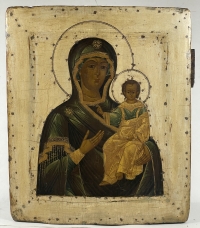

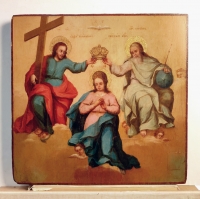
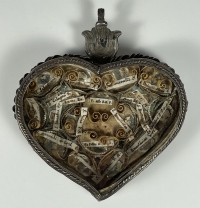
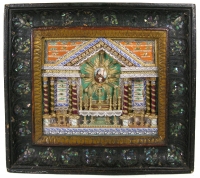

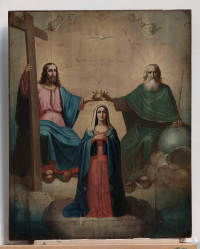
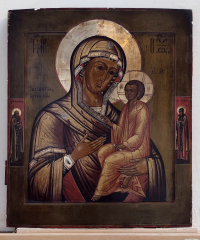
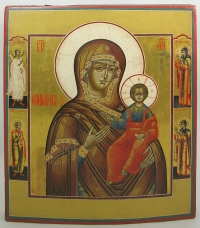
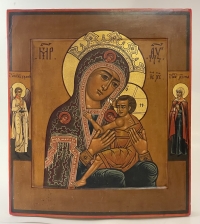



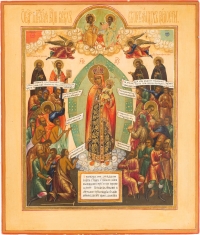

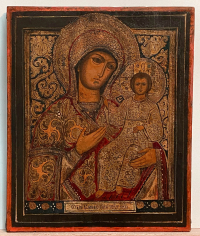


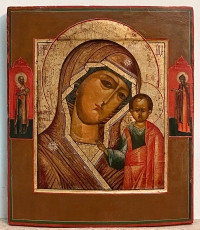
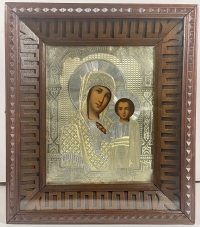
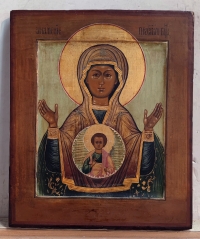
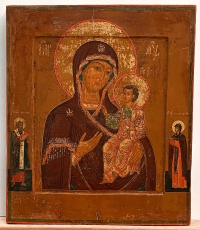

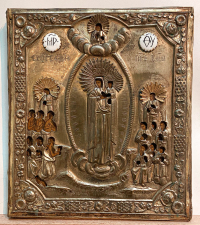
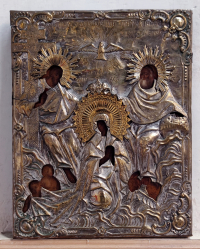

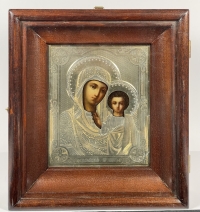
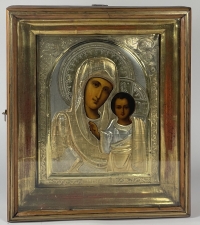



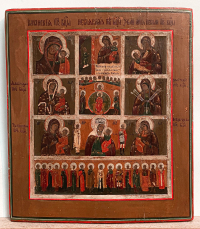
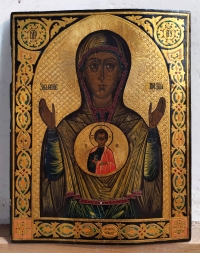
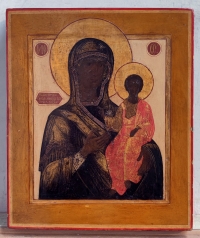
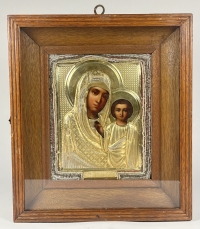
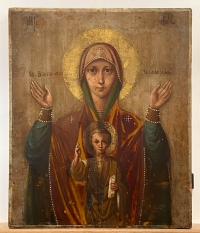
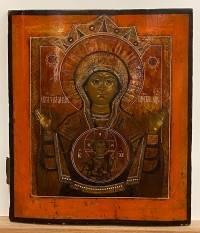
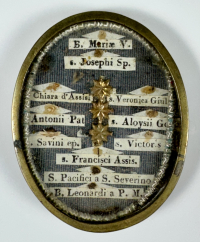
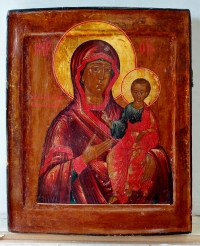
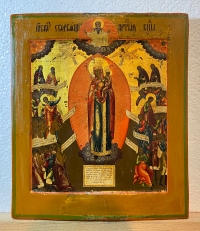


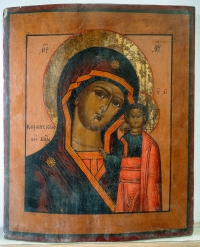

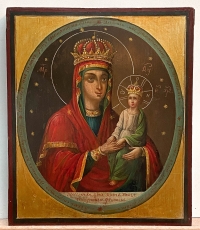
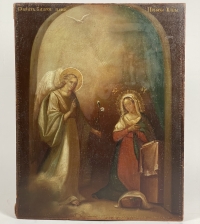

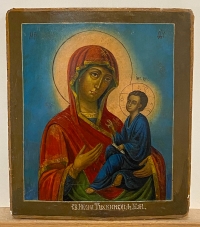
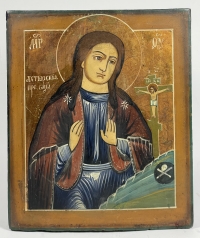



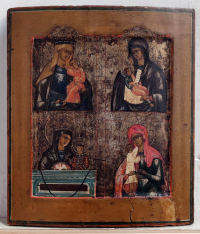
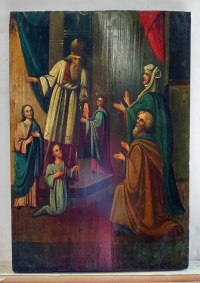
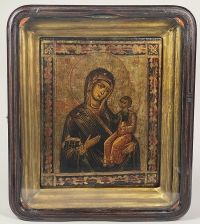
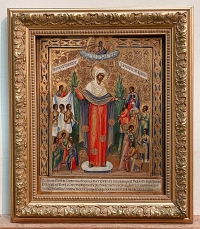

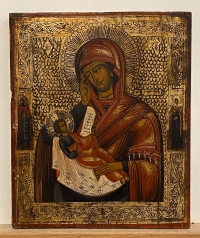

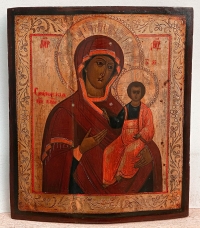




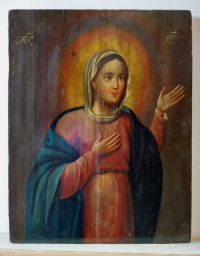
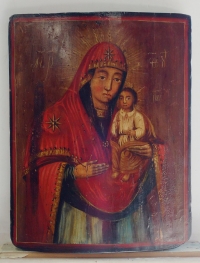
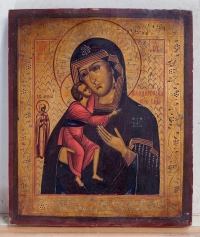

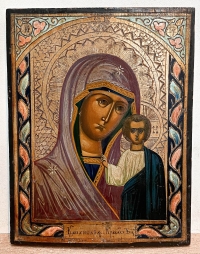
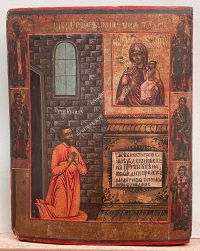
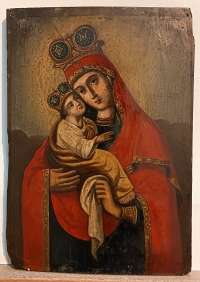

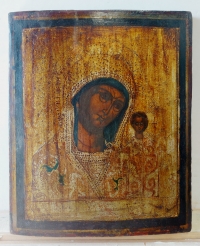
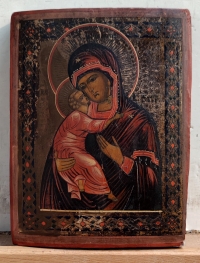

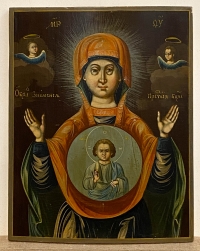
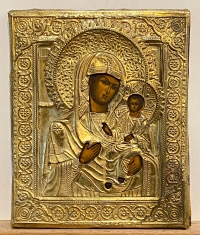
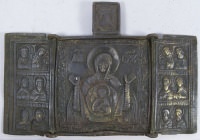

 Поменять язык на русский
Поменять язык на русский 